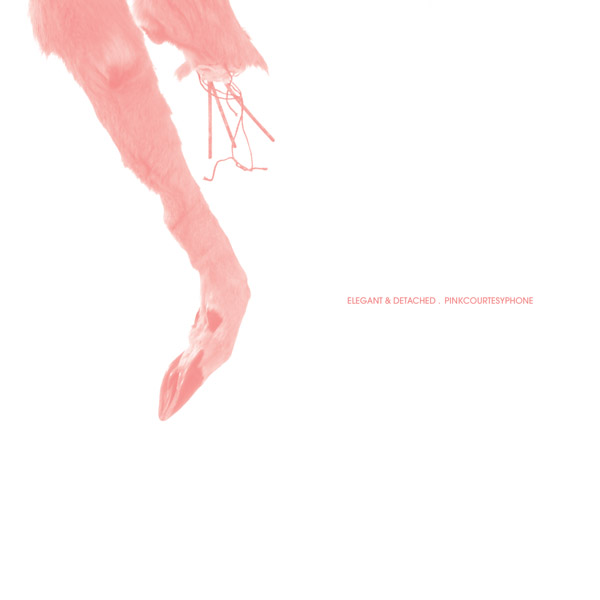 Under his Pinkcourtesyphone guise, Richard Chartier has found a way to inject a bit of levity and humor into his otherwise serious and formal electronic compositions. These two recent releases reiterate this, but also present an evolution in PCP’s sound, from avant garde electronics to traditional and rhythmic works that have recognizable points of reference, but still stand as entirely unique in this often crowded genre.
Under his Pinkcourtesyphone guise, Richard Chartier has found a way to inject a bit of levity and humor into his otherwise serious and formal electronic compositions. These two recent releases reiterate this, but also present an evolution in PCP’s sound, from avant garde electronics to traditional and rhythmic works that have recognizable points of reference, but still stand as entirely unique in this often crowded genre.
Elegant & Detached, the full length album on Room40, is consistent with the first PCP album, Foley Folly Folio in its use of more relaxed, but still challenging tones and electronics.The use of various actress dialogue samples emphasizes the PCP aesthetic of electro acoustic music for bored 1950s housewives who love wine and barbiturates.This sensibility stretches into the music rather well:the echoing and processing used throughout "Sans Motif/Closer to Here Than You Care to Be" encapsulates a disoriented, valium like haze that drifts into self-aware new age camp towards its conclusion."An Awaiting Room (for Tati)/Stars Fell" has a sound that covers Chartier's solo work and this project, with its crackly, low end textures at its opening, being more in line with his more formal material.As it goes on, the sound becomes lighter and buoyant via heavy reverb and echo, with the string flourishes that appear toward the end adds in just the right amount of kitsch.Hinting at the future is the closing "Sans Many Things", which features a more structured series of thuds and fragments of digital bells that, even through its DSP heavy sound has a deconstructed minimal techno feel.
samples:
 
- Sans Motif/Closer to Here than You Care to Be
- An Awaiting Room (for Tati)/Stars Fell
- Sans Many Things (Bedtime)

That techno feel heralds the sound of the combination remix/new material album Please Pick Up.The first half of it is made up of outsourced remixes by many of the artists who have appeared on Chartier's LINE label, but even they seem to be stepping outside their comfort zone into more rhythmic works.Frank Bretschneider's take on "An Awaiting Room" is focused upon a thin, but effective rhythmic passage throughout that eventually becomes full on techno in its closing moments, while still remaining tastefully hushed.
Yves de Mey's mix of "Singularity Version" also embraces an abstract take on rhythm and structure, with its ultra low rumble and rattlesnake like synth sequences holding things together nice and orderly.Similarly, the echoing, textural layers that are sequenced together on "Pinkcourtesypjusk" (by Pjusk) are a bit further removed from conventional sounds, but still maintain that sense of rhythm and structure.
The weaker pieces on this first half are those that just do not manage to stand out as distinctly amongst the original work.Evelina Domnitch and Dmitry Gelfand's mix of "Sans" is deconstructed down to expansive tones and harrowing space, while "Here is Something…That is Nothing" by Yann Novak and Robert Crouch strips the piece down to its barest essentials into an ultra minimalist composition.Both are exceptional for what they are, but next to the more rhythmic pieces they just are not quite as gripping.
The second half of the album is material performed with Kid Congo Powers (The Cramps, Gun Club) on vocals, which gives a very different feel to these songs.Powers' sinister, sleazy delivery on the cover of Amanda Lear’s "imaphotograph" has the right amount of creepy to tart it up, and with its rudimentary thud/white noise rhythmic backing resembles a stripped down mash up of Throbbing Gristle’s "United" and "Persuasion.""Move to Trash" is even creepier, with its lurching pace and Powers' vocals tossing out one double entendre after the next.Between these two songs, I was definitely catching a more modernist, avant garde Soft Cell vibe, with all of the underlying filth and perversion presented in their resplendent glory."iamaphotograph" appears in a few remixed versions, with each bringing out different musical elements:Creepy Autograph's mix brings up nasal sawtooth oscillators and a bit of arpeggiated synth, while CoH chooses to cut up and fragment the voices extensively.Like most remixes, they expand on different parts of the original work, but never surpass it.
I am a long time fan of Chartier's more serious, academic tinged work, but the development and expansion of Pinkcourtesyphone is a different beast entirely.The inclusion of more conventional bits, such as overt rhythmic passages and the use of vocals go a long way and help solidify the singular identity of the project.I do not figure Chartier will leave his more serious artist career behind, nor would I want him to, so PCP makes for the perfect side project that continues to develop its own distinct identity.
samples:
 
Read More

